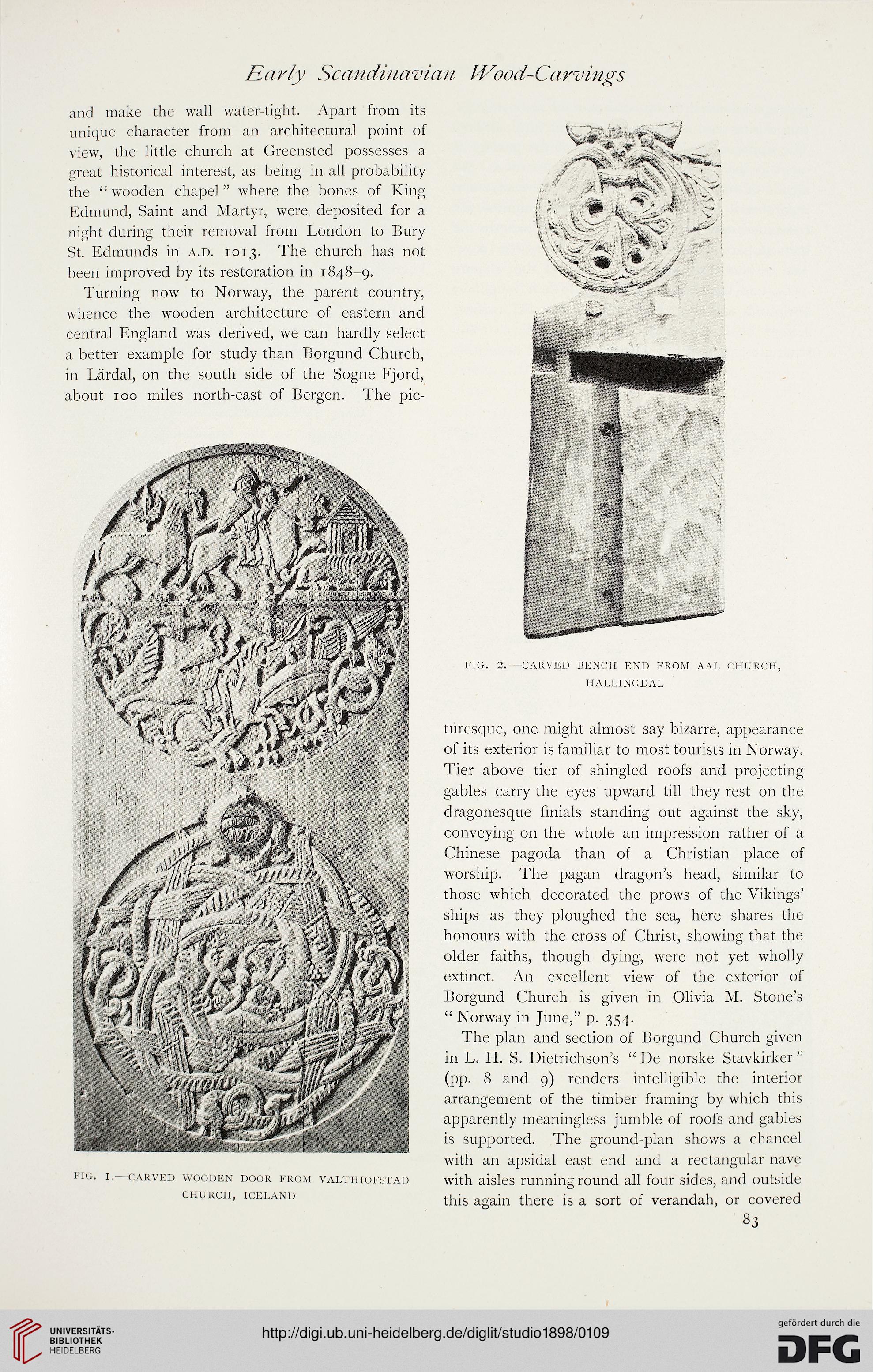Early Scandinavian Wood-Carvings
and make the wall water-tight. Apart from its
unique character from an architectural point of
view, the little church at Greensted possesses a
great historical interest, as being in all probability
the " wooden chapel" where the bones of King
Edmund, Saint and Martyr, were deposited for a
night during their removal from London to Bury
St. Edmunds in a.d. 1013. The church has not
been improved by its restoration in 1848-9.
Turning now to Norway, the parent country,
whence the wooden architecture of eastern and
central England was derived, we can hardly select
a better example for study than Borgund Church,
in Lardal, on the south side of the Sogne Fjord,
about 100 miles north-east of Bergen. The pic-
FIG« l-—carved wooden door from valthiofstad
church, iceland
fig. 2.—carved bench end from aal church,
hallinodal
turesque, one might almost say bizarre, appearance
of its exterior is familiar to most tourists in Norway.
Tier above tier of shingled roofs and projecting
gables carry the eyes upward till they rest on the
dragonesque finials standing out against the sky,
conveying on the whole an impression rather of a
Chinese pagoda than of a Christian place of
worship. The pagan dragon's head, similar to
those which decorated the prows of the Vikings'
ships as they ploughed the sea, here shares the
honours with the cross of Christ, showing that the
older faiths, though dying, were not yet wholly
extinct. An excellent view of the exterior of
Borgund Church is given in Olivia M. Stone's
" Norway in June," p. 354.
The plan and section of Borgund Church given
in L. H. S. Dietrichson's " De norske Stavkirker "
(pp. 8 and 9) renders intelligible the interior
arrangement of the timber framing by which this
apparently meaningless jumble of roofs and gables
is supported. The ground-plan shows a chancel
with an apsidal east end and a rectangular nave
with aisles running round all four sides, and outside
this again there is a sort of verandah, or covered
33
and make the wall water-tight. Apart from its
unique character from an architectural point of
view, the little church at Greensted possesses a
great historical interest, as being in all probability
the " wooden chapel" where the bones of King
Edmund, Saint and Martyr, were deposited for a
night during their removal from London to Bury
St. Edmunds in a.d. 1013. The church has not
been improved by its restoration in 1848-9.
Turning now to Norway, the parent country,
whence the wooden architecture of eastern and
central England was derived, we can hardly select
a better example for study than Borgund Church,
in Lardal, on the south side of the Sogne Fjord,
about 100 miles north-east of Bergen. The pic-
FIG« l-—carved wooden door from valthiofstad
church, iceland
fig. 2.—carved bench end from aal church,
hallinodal
turesque, one might almost say bizarre, appearance
of its exterior is familiar to most tourists in Norway.
Tier above tier of shingled roofs and projecting
gables carry the eyes upward till they rest on the
dragonesque finials standing out against the sky,
conveying on the whole an impression rather of a
Chinese pagoda than of a Christian place of
worship. The pagan dragon's head, similar to
those which decorated the prows of the Vikings'
ships as they ploughed the sea, here shares the
honours with the cross of Christ, showing that the
older faiths, though dying, were not yet wholly
extinct. An excellent view of the exterior of
Borgund Church is given in Olivia M. Stone's
" Norway in June," p. 354.
The plan and section of Borgund Church given
in L. H. S. Dietrichson's " De norske Stavkirker "
(pp. 8 and 9) renders intelligible the interior
arrangement of the timber framing by which this
apparently meaningless jumble of roofs and gables
is supported. The ground-plan shows a chancel
with an apsidal east end and a rectangular nave
with aisles running round all four sides, and outside
this again there is a sort of verandah, or covered
33




